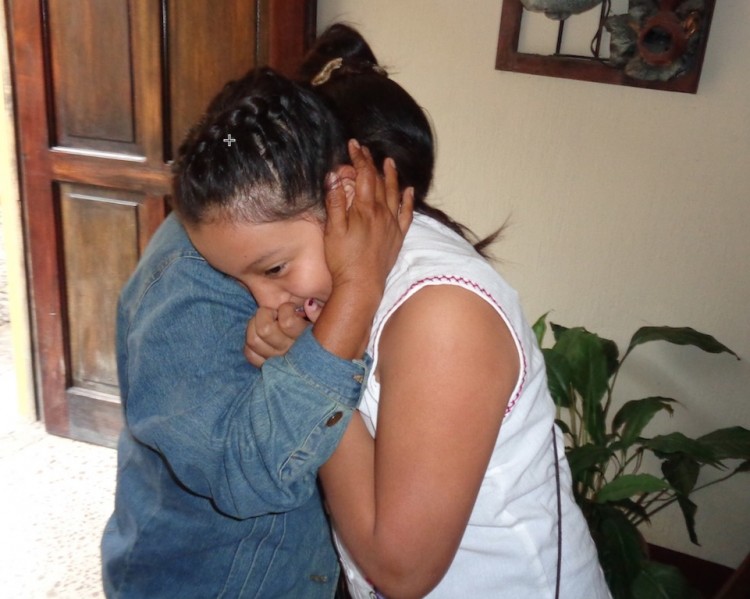
When we first thought about having a family, we imagined a biological child. Because half of my family perished in the Holocaust, I had a strong need to continue our family’s legacy. After more than two years, we were blessed with a beautiful baby girl. We were smitten, and also felt the need to provide her with a sibling.
One of the challenges that we faced was that we are a two-mom family. The effort to have a child biologically took several years. We were in the process of trying for a second biological child when my partner Ginny was diagnosed with breast cancer. I therefore postponed trying to get pregnant again.
Six months after Ginny’s diagnosis, she encouraged me to attend an adoption conference at Open Door Society (ODS). There we met the agency that would assist us in adopting our second child.
We faced barriers of age (being over 40) and the fact that I had to apply as a single mother (because no country would accept us as a couple). Having a first child, we learned, was in our favor. There were only three countries where we could adopt and one of these was Guatemala. We thought this made sense because our first child, Antonetta, is biologically Latina.
Just prior to learning about our adopted daughter Maya’s birth in 2005, Ginny, Antonetta and I traveled to Guatemala to learn about the country. On the recommendation of a friend who had lived there, we traveled various parts of the country and fell in love with the land and the open heart of the people.
In Guatemala we met Martita and Oscar, a couple who had dedicated their lives to helping the poor. We observed hundreds of homeless line up at their front door every morning and receive black beans, oatmeal, and a cup of coffee. We told Martita and Oscar that we were adopting a Guatemalan baby. They welcomed our news with open arms and said they couldn’t wait to be the baby’s Guatemalan grandparents.
When I returned to Guatemala to adopt Maya, Martita wanted to meet our 7-month-old baby. And, she wanted to do so again when we returned one year later, to reacquaint Maya with her native country. However, Martita was unable to visit.
Sadly, a few months later, Martita passed away. Soon afterwards, Oscar succumbed to cancer. Through this loving couple, we met their daughter Marta, who is carrying on her parents’ mission. We have continued our connection through the years.
In 2011, Maya, age 6, told a dear friend of ours from Guatemala that she would like her to help find her mom. Maya communicated this same urgency to Ginny and me. I understood from my own loss of biological family the importance of connection to one’s family of origin. I also knew that Maya has a strong sense of self in our adopted family.

This past January (2015), four years after Maya communicated her desire to find her biological mom, we located her. We learned that Olivia is a 31-year-old indigenous Mayan woman. She lives with her two younger children, ages 8 and 2, and her extended family of 30 in a remote tiny village. Their homes have earthen floors. Plastic sheeting is used to keep out the persistent rain. As you might guess, Olivia's day-to-day childhood existence was a struggle. At age 21, she became pregnant. As she would have been outcast as a single woman raising a child alone in her village and she did not have the economic means to do so, she gave her firstborn daughter up for adoption. Yet, her heart yearned for her child. Every day she wondered about her little girl. She never knew what happened to her baby. She thought she’d never see her again.
We learned that all three of Olivia’s children were delivered by Cesarean section. When the youngest was born, she fell into a deep depression and became unable to work. Because of her economic situation, her health declined. When we located Olivia, it was apparent that she was in need of medical attention.
During this time, our friend Marta was in the process of starting a non-governmental organization (NGO) to aid the poor gain access to local medical care. Through Marta and a funding campaign, we were able to get Olivia the beginning basics of medical care. It was also learned that her village of 100 needs self-sustaining income.
In April, Marta’s friend Ricardo and an agricultural engineer went to the village, delivering food and water filters. Ricardo brought a letter written by Maya along with recent photos. When Olivia saw the letter and photos, she exclaimed, “Thank God, my daughter is safe!” Since that visit, Ricardo has been working to create an NGO to aid the entire village to become self-sustaining.
Thanks to Ricardo’s efforts, in July, Maya met Olivia, and her Aunt Lety, after 10 years. They traveled eleven hours to meet us. We said that we were connected as family and would not forget one another. They were extremely grateful for everything we had done and that we had brought Maya on such a long trip to come back to her roots.
Maya hugged Olivia and later told me, “I can still feel my mother’s heartbeat.” At the end of the visit, Olivia put her head down. She was deeply sad. I asked Lety if she thought that Olivia would be better from the experience of being together. She said, “Definitely better.” Maya told us that she felt like it was a dream. The reunion was emotional, even across three languages.

I told Lety that when Maya was little I told her to look at the stars and that the stars were the same ones that her birth mother could see in the sky. I told Lety that I felt it was very important to be connected with one’s roots and family of origin. I said that I felt this way because my father’s entire family was killed during the second world war because of our religion. I also told her that because a courageous woman saved my father’s life, I learned that the future can have hope.
Currently, Ricardo, Marta and their team are developing a pilot project for Olivia’s village for their NGO, CorGuate, which stands for Corazones en Acción por Guatemala, or Actions of the Heart for Guatemala. The name is appropriate because Olivia’s people relate to one another by referring to the heart, in their greetings and inquiries about one another’s well-being.
Ricardo and his team extensively researched many options and determined that growing Tabasco chilis would be most successful in the region. They showed us a video of a similar project in Nicaragua that supports families and has a steady market, thanks to the support of USAID. They plan to replicate this concept in Olivia's village. We have set up a Kickstarter campaign to raise additional funds to cover the costs of the work that they have done and the upcoming work of traveling to the village to set up the business.
Our personal resources are small, but we have a lot of energy to make this happen with the partnership of others. To learn more about what is being accoplished for Maya's village through Actions of the Heart for Guatemala sustainablility project please click here.






